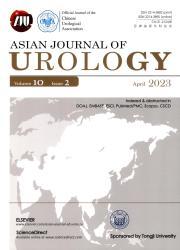A review based on expert opinions for robot-assisted simple prostatectomy for large benign prostatic hyperplasia
IF 2.4
3区 医学
Q2 UROLOGY & NEPHROLOGY
引用次数: 0
Abstract
Objective
Robot-assisted simple prostatectomy (RASP) is increasingly used as a surgical treatment option for large benign prostatic hyperplasia (BPH) (>80 mL). However, there is no sufficient expert consensus or guidelines to guide clinical practice. We aimed to obtain expert opinions for RASP for large BPH.
Methods
A systematic review of the literature was performed in April 2024 using the PubMed, Embase, and Web of Science databases. Search terms were combined to construct the following search strings: (robotic) AND (simple OR benign) AND (prostatectomy). Search results were filtered by language (English only), species (human), and publication type (original article). This study used a two-phase modified Delphi approach.
Results
In this expert consensus, some frequently used RASP techniques, including robot-assisted retropubic prostatectomy, robot-assisted transvesical prostatectomy, and robot-assisted urethra-sparing prostatectomy, are described. RASP offers a short learning curve for surgeons with experience in robotic surgery. Severe complications are rare in patients who undergo RASP.
Conclusion
RASP technique can be recommended as a safe and effective minimally invasive treatment for symptomatic BPH patients with large prostate glands.
基于专家意见的机器人辅助单纯性前列腺切除术治疗大型良性前列腺增生的综述
目的:机器人辅助的单纯前列腺切除术(RASP)越来越多地被用作大型良性前列腺增生(BPH) (>80 mL)的手术治疗选择。然而,没有足够的专家共识或指南来指导临床实践。我们的目的是获得RASP治疗大型BPH的专家意见。方法于2024年4月使用PubMed、Embase和Web of Science数据库对相关文献进行系统综述。将搜索词组合起来构建以下搜索字符串:(机器人)和(简单或良性)和(前列腺切除术)。搜索结果按语言(仅限英语)、物种(人类)和出版物类型(原创文章)进行过滤。本研究采用两阶段改进的德尔菲法。结果在专家共识中,介绍了一些常用的RASP技术,包括机器人辅助耻骨后前列腺切除术、机器人辅助经膀胱前列腺切除术和机器人辅助保留尿道前列腺切除术。RASP为有机器人手术经验的外科医生提供了一个简短的学习曲线。接受RASP的患者很少出现严重的并发症。结论rasp技术可作为一种安全有效的微创治疗伴有大前列腺的症状性前列腺增生患者。
本文章由计算机程序翻译,如有差异,请以英文原文为准。
求助全文
约1分钟内获得全文
求助全文
来源期刊

Asian Journal of Urology
UROLOGY & NEPHROLOGY-
CiteScore
4.00
自引率
3.80%
发文量
100
审稿时长
4 weeks
期刊介绍:
Asian Journal of Urology (AJUR), launched in October 2014, is an international peer-reviewed Open Access journal jointly founded by Shanghai Association for Science and Technology (SAST) and Second Military Medical University (SMMU). AJUR aims to build a communication platform for international researchers to effectively share scholarly achievements. It focuses on all specialties of urology both scientifically and clinically, with article types widely covering editorials, opinions, perspectives, reviews and mini-reviews, original articles, cases reports, rapid communications, and letters, etc. Fields of particular interest to the journal including, but not limited to: • Surgical oncology • Endourology • Calculi • Female urology • Erectile dysfunction • Infertility • Pediatric urology • Renal transplantation • Reconstructive surgery • Radiology • Pathology • Neurourology.
 求助内容:
求助内容: 应助结果提醒方式:
应助结果提醒方式:


